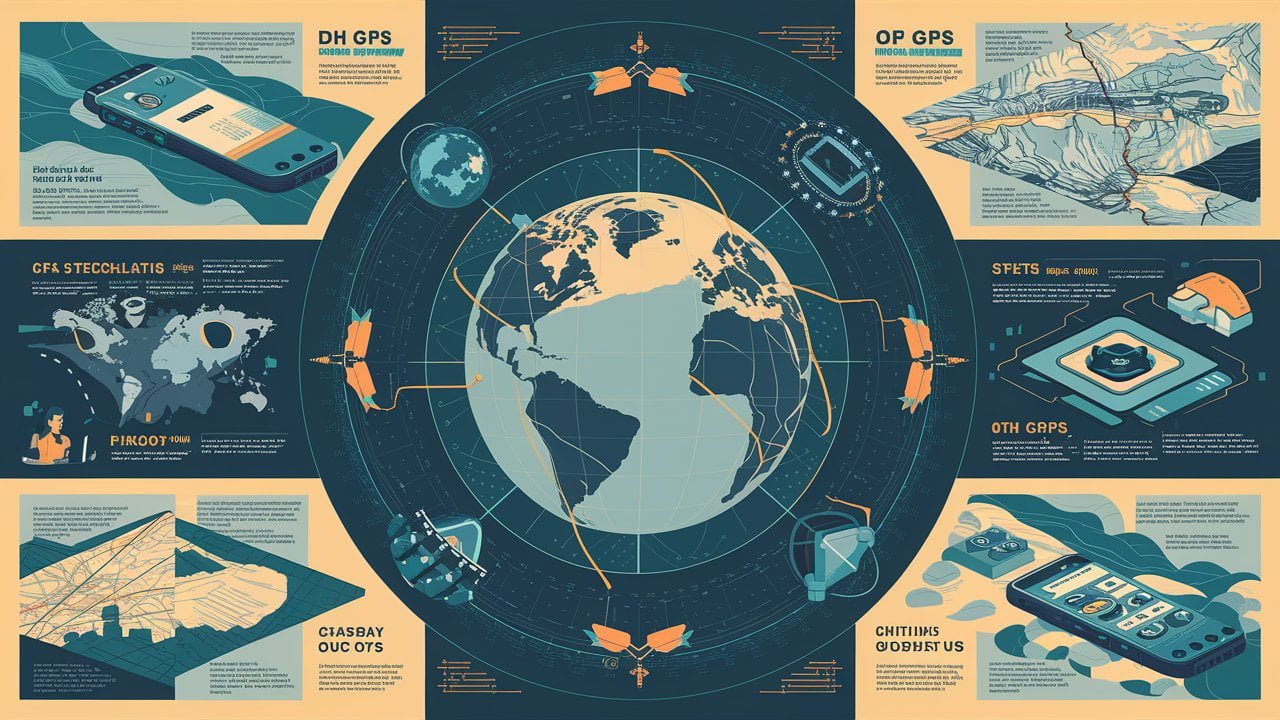As travelers embark on their journeys, and outdoor adventurers navigate uncharted territories, the intricate dance of GPS technology quietly orchestrates their every move. Global Positioning System (GPS), a revolutionary tool born out of space exploration, stealthily weaves its signals to pinpoint exact locations with unprecedented accuracy.
Understanding this technological marvel is not merely a matter of convenience; it is the very compass that guides our modern-day voyages with precision and efficiency.
For those enraptured by the allure of travel, delving into the depths of GPS in navigation unveils a realm of possibilities previously unfathomed. What was once an enigma shrouded in satellites and algorithms now emerges as the cornerstone of seamless route planning and location tracking for intrepid explorers worldwide.
Embracing the intricacies of GPS isn’t just an option—it is a pivotal stride towards mastering the art of navigating our planet’s vast tapestry, empowering adventurers to tread terrains far and wide with unwavering confidence and assurance.
In unraveling the mystery that is GPS technology, travelers unearth a wealth of insights that illuminate their paths like never before, transforming exploration into an exhilarating symphony orchestrated by unseen celestial guardians.
Understanding the Basics of GPS.
GPS, or Global Positioning System, is a network of satellites that orbit the Earth and provide precise location data to GPS receivers on the ground. This technology enables users to determine their exact position anywhere on the globe, thanks to trilateration—where signals from multiple satellites are used to pinpoint a device’s location.
Picture your smartphone guiding you through winding trails in a national park or navigating busy city streets; all made possible by the intricate interplay between satellites and your GPS device.
Satellites play a crucial role in ensuring the accuracy of GPS navigation. The more satellites your device can connect with, the more precise its calculations become. For instance, when hiking in remote areas with limited visibility landmarks, relying on GPS for accurate coordinates becomes indispensable.
These space-based beacons constantly transmit signals containing information about their position and time, which your GPS receiver uses to calculate distances and ultimately display your exact whereabouts.
The benefits of GPS technology extend beyond mere convenience; they empower travelers with real-time tracking capabilities and efficient route planning functionalities. Imagine embarking on a road trip where you can effortlessly adjust your course based on live traffic updates provided by your GPS system, helping you avoid congestion and save time.
Additionally, outdoor enthusiasts can mark key points of interest along their hiking path or log their trail for future reference—all made seamless by harnessing the power of GPS technology for navigation purposes.
Evolution of GPS Technology.
The journey of Global Positioning System (GPS) technology is a fascinating one that showcases remarkable advancements over the years. Initially developed by the United States Department of Defense for military purposes, GPS has transitioned into an indispensable tool for civilian use.
Dating back to the 1970s when GPS was primarily designed for precise navigation by military personnel, its evolution has been substantial. The system’s transformation from a military-centric application to a ubiquitous civilian utility highlights its adaptability and innovation.
As GPS technology progressed, so did the devices and applications that harnessed its capabilities. From bulky handheld units used predominantly by hikers to sleek and feature-rich smartphones that offer navigation at our fingertips, the accessibility and convenience provided by GPS-enabled devices have revolutionized travel and outdoor activities.
Furthermore, the advent of specialized GPS applications tailored to various niches, such as geocaching or marine navigation, underscores the versatility of this technology in catering to diverse user needs.
The impact of GPS on the travel industry and outdoor pursuits cannot be overstated. Tourists can now confidently navigate unfamiliar territories with ease, thanks to turn-by-turn guidance from GPS-enabled car systems or mobile apps like Google Maps.
For adventurers exploring remote wilderness areas, handheld GPS units provide a crucial lifeline by ensuring accurate positioning even in challenging conditions. The integration of real-time tracking features in wearable GPS devices has enhanced safety measures for hikers and climbers, enriching their experiences while mitigating risks associated with outdoor adventures.
Ultimately, the evolution of GPS technology continues to shape and streamline how we navigate our world, contributing significantly to both leisurely travels and professional endeavors alike.
GPS Devices for Navigation.
In the realm of navigation tools, a variety of GPS devices cater to different needs and preferences. Handheld GPS units, known for their rugged durability and longer battery life, are favored by hikers and outdoor enthusiasts venturing into remote areas where cellphone coverage may be scarce.
These units offer detailed topographic maps and special features like geocaching support. On the other hand, smartphones have become ubiquitous GPS companions due to their versatility and convenience.
Apps like Google Maps provide turn-by-turn directions, traffic updates, and even offline maps functionality. However, reliance on smartphones for navigation in the wilderness raises concerns over battery usage and signal reception.
Car systems equipped with GPS technology offer seamless integration with your vehicle’s dashboard display, providing voice-guided navigation in a familiar format. These systems often come with advanced features such as lane assistance, real-time traffic updates, and points of interest along the route.
When selecting a GPS device tailored to specific needs, factors like portability, battery life, screen size, map updates frequency, ease of use, waterproofing (for outdoors), and additional features like Bluetooth connectivity or camera integrations play essential roles in decision-making.
For instance, if you are an avid road tripper who values real-time traffic information combined with user-friendly interfaces without draining your phone’s battery life or internet data plan while navigating through remote locations en route to national parks or scenic routes; investing in a car system might align best with your requirements.
Conversely, if you are planning a backcountry trek where weather resistance and long-lasting battery performance take precedence over unnecessary bells and whistles; opting for a handheld GPS unit specifically designed for rugged outdoor use could be more suitable. Understanding these nuances allows users to maximize the benefits offered by various GPS devices based on their intended applications.
Utilizing GPS for Travel Planning.
When it comes to travel planning, leveraging GPS technology can significantly enhance your trip experience. One crucial tip is to always ensure that your maps and software are up to date to guarantee accurate navigation. Outdated maps could lead you astray, especially when exploring unfamiliar territories.
By updating your GPS device regularly, you equip yourself with the most current road networks, attractions, and points of interest, ensuring a seamless journey from start to finish. For example, if you’re embarking on a road trip through Europe and plan to visit multiple countries, having the latest map updates can save you from unexpected road closures or detours.
Integrating weather information with GPS data is another smart strategy that travelers can employ for safe traveling. Many advanced GPS systems now offer real-time weather updates along with navigation services.
By syncing weather data with your route guidance, you can proactively adjust your travel plans in case of adverse conditions like heavy rain or snowstorms. For instance, before setting off on a hiking expedition in the mountains using a handheld GPS unit with integrated weather forecasts can help you anticipate changes in weather patterns throughout the day and make informed decisions regarding your hiking route.
Additionally, understanding how to optimize waypoints and routes using your GPS device is essential for efficient trip planning. Whether it’s plotting multiple stops on a road trip or creating a detailed hiking trail itinerary, employing these features can streamline your journey and maximize time spent enjoying destinations rather than figuring out directions.
By customizing your route preferences based on traffic patterns or scenic routes available on certain GPS devices like car navigational systems or smartphone apps, travelers can tailor their adventures to suit their preferences while making the most of their travels without unnecessary detours or delays.
GPS Navigation Challenges and Solutions.
Navigating using GPS technology comes with its own set of challenges that often test the patience of travelers and adventurers alike. Signal loss or inaccuracies in remote areas are common hurdles faced when relying on GPS for navigation.
Imagine trekking through a dense forest or navigating vast deserts where satellite signals might struggle to reach you accurately, leading to misinterpreted directions. To address this challenge, one effective solution is to download offline maps before embarking on such trips.
By preloading maps onto your device, you can access crucial navigation information even when connectivity is limited, ensuring you stay on the right path despite signal disruptions.
Moreover, another prevalent concern among GPS users is the rapid drainage of battery life due to continuous reliance on GPS functionalities. This issue is especially crucial during extended outdoor activities like backpacking or camping trips where access to charging points may be limited.
One way to mitigate battery drainage is by adjusting settings on your GPS device to optimize power consumption. Dimming screen brightness, disabling unnecessary background apps, and using battery saver modes can significantly extend the lifespan of your device’s battery while still enjoying uninterrupted navigational support.
Furthermore, when facing unforeseen obstacles like incorrect routes suggested by GPS applications or sudden recalculations due to inaccurate signals, having a backup plan becomes essential. Supplementing GPS data with traditional maps or compasses can serve as a failsafe measure in such scenarios.
By integrating analog navigation tools alongside digital GPS systems, travelers can navigate confidently regardless of technological hiccups they encounter along their journeys. Adapting to these challenges with practical solutions ensures that the benefits of GPS technology outweigh its limitations, providing seamless navigation experiences for all types of explorers and adventurers alike.
Future Trends in Navigation Technology.
As the landscape of navigation technology continues to evolve rapidly, future trends promise even more innovative solutions to enhance our travel experiences. One exciting development on the horizon is the integration of augmented reality (AR) in navigation systems.
AR overlays digital information onto the real world, providing users with interactive and immersive guidance. For instance, travelers could soon have access to visual cues superimposed on their surroundings through smart glasses or smartphone apps, offering a new dimension to traditional GPS navigation.
Another trend set to revolutionize navigation is the incorporation of AI-powered assistants for personalized route guidance. Imagine having a virtual navigator that knows your preferences, learns from your habits, and can suggest optimized routes based on real-time traffic data and historical patterns.
These AI assistants could provide tailored recommendations for places to visit, pit stops along the way, and even adjust routes dynamically to avoid congestion or unexpected road closures, ensuring a smoother journey for travelers.
Furthermore, green technology initiatives are shaping future developments in GPS navigation by focusing on sustainability and energy efficiency. Companies are exploring ways to reduce carbon footprints by optimizing routes for fuel efficiency and promoting eco-friendly transportation options through GPS applications.
For example, GPS devices could soon prioritize electric vehicle charging stations along routes or offer eco-friendly travel suggestions based on environmental impact assessments, aligning technological advancements with environmental conservation efforts. Embracing these green initiatives will not only benefit travelers but also contribute to a more sustainable future for generations to come.
In conclusion, staying abreast of these emerging trends in navigation technology is key to unlocking the full potential of GPS innovation for travelers and outdoor enthusiasts alike.
By embracing augmented reality features, AI-powered assistance capabilities, and environmentally conscious solutions within GPS navigation systems, users can expect more intuitive guidance, enhanced personalization, and sustainable practices in their journeys.
Exploring these future trends enables individuals to make informed decisions while embarking on adventures with confidence in the capabilities of modern navigational tools crafted by cutting-edge technologies.
Unleashing the Potential of GPS Innovation.
In conclusion, understanding the intricacies of modern GPS technology is paramount for travelers, tech enthusiasts, and outdoor adventurers alike. Embracing the advancements in navigational tools provided by GPS opens a world of precise location tracking, real-time route planning, and enhanced travel experiences.
The evolution of GPS devices has revolutionized navigation both on the road and off the beaten path, offering unparalleled accuracy and convenience.
As we move forward, I encourage readers to delve deeper into the new features and applications emerging in the field of GPS navigation. By staying updated on the latest trends like augmented reality integration and AI-powered assistants for personalized guidance, users can unlock even more potential for seamless travels.
Understanding modern GPS not only empowers individuals with reliable navigation but also enriches their journeys by enabling efficient trip planning and safe exploration of diverse landscapes. As we continue to harness the power of GPS innovation, let’s navigate confidently towards new horizons filled with exciting possibilities in travel and adventure.



